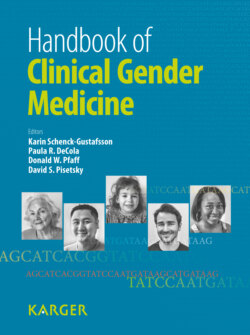Читать книгу Handbook of Clinical Gender Medicine - Группа авторов - Страница 43
Hormonal and Genetic Aspects of Fetal Sex Determination
ОглавлениеOne of the most crucial time windows which the human embryo faces occurs during a few hours sometime between 41 and 44 days after conception (in obstetrical terms during the 6th week of pregnancy). During these few fateful hours in that narrow time window, nature determines whether the developing fetus will be phenotypically male or female. Of course, chromosomal sex determination has already taken place during fertilization but, phenotypically, all odds are still open. If nothing happens during this time window, the embryo will by default develop into a phenotypic female. However, if a Y chromosome is present and a very specific single gene which is located on the short arm of that Y chromosome is activated, then the primitive gonad develops into a testicle and soon begins to secrete large amounts of testosterone and the embryo begins its development to become a phenotypic male. This sex-determining gene is named after its location on the Y chromosome, hence sex-determining region on the Y chromosome, in short SRY. The ensuing enormous testosterone production of the fetal testes will have a crucial impact on the subsequent development of intrauterine and extrauterine gender differences.
The chromosomal makeup and the hormonal environment and the appropriate functional receptors for various hormones thus determine the phenotypic sex.
